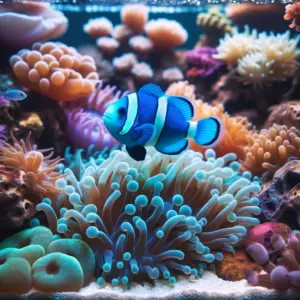Blue Clownfish
1. Introduction to Blue Clownfish
1.1. Fascination with Blue Clownfish
My journey into the mesmerizing world of blue clownfish began years ago, and it has been a captivating experience ever since. These remarkable creatures are not just another fish in the sea; their striking blue hues set them apart, making them a centrepiece in any marine aquarium. Their playful nature and unique appearance have not only piqued my interest but also that of many aquarists around the world. In this article, I aim to share the allure and knowledge I’ve gathered about these clownfish, providing insights and practical advice for fellow enthusiasts.
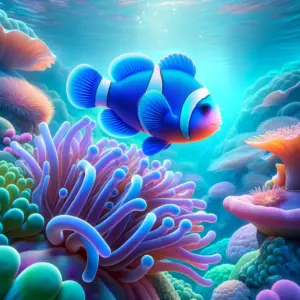
1.2. Overview of the Species
Blue clownfish, a variant of the common clownfish, stand out due to their unique blue coloration. These marine beauties are often the highlight of coral reef ecosystems, where they form a fascinating symbiotic relationship with sea anemones. Understanding their behavior, dietary needs, and environmental requirements is crucial for anyone looking to nurture these fish in a home aquarium. In this article, we’ll delve deep into the world of blue clownfish, exploring everything from their natural habitat to the intricacies of their care and breeding.
2. Understanding the Habitat of Blue Clownfish
2.1. Natural Habitat and Conditions
In their natural coral reef habitat, blue clownfish flourish in warm, shallow waters. These areas are rich in biodiversity, providing the perfect backdrop for their symbiotic relationship with sea anemones. The anemones offer protection, while the clownfish, in return, aid in the anemone’s feeding and provide cleanliness. Replicating this environment in a home aquarium is not just about aesthetics; it’s about creating a sustainable ecosystem that caters to their behavioral and physiological needs.
2.2. Importance of Replicating Natural Habitat in Aquariums
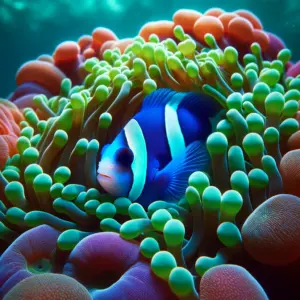
For these clownfish to thrive in captivity, it is imperative to closely mimic their natural habitat. This involves more than just replicating water conditions like temperature and salinity; it’s about understanding the ecosystem dynamics of a coral reef. This includes providing an appropriate layout with hiding places and potential hosts like anemones or similar structures. By creating an environment that resembles their natural habitat, we not only ensure their health and wellbeing but also get to witness their most natural and intriguing behaviors.
3. Caring for Blue Clownfish
3.1. Tank Requirements
Creating a suitable home for these clownfish starts with the right tank setup. A minimum tank size of 20 gallons is recommended for a pair, but more space is always better, especially if you plan to introduce more fish or sea anemones. The tank should include features that mimic a natural reef, such as live rocks and crevices, providing both a playground and refuge for these fish. Adequate lighting and a stable filtration system are also essential to maintain the health of the tank ecosystem.
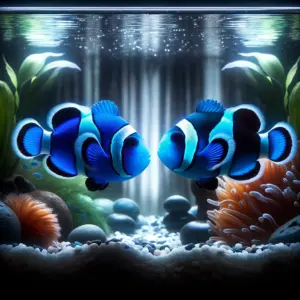
3.2. Water Conditions and Maintenance
Maintaining optimal water conditions is crucial for the health of blue clownfish.
The water temperature should be kept between 75 to 80°F (23.9 to 26.7°C).
The pH level should be ranging from 8.1 to 8.4, & specific gravity between 1.020 & 1.025.
Regular monitoring and adjustments are necessary to keep these parameters stable. Additionally, routine water changes, at least 10-15% biweekly, are vital to remove toxins and replenish essential minerals, ensuring a healthy environment for your clownfish.
3.3. Diet and Feeding Practices
The diet of blue clownfish should be varied and nutritious to ensure their vibrant coloration and overall health. In the wild, their diet includes algae, zooplankton, and small crustaceans. In captivity, a mix of high-quality commercial fish food, supplemented with fresh or frozen seafood like shrimp and squid, is ideal. Feeding them small portions two to three times a day is recommended. Observing their feeding habits and adjusting the quantity accordingly is crucial to prevent overfeeding and maintain water quality.

4. Breeding Blue Clownfish
4.1. Breeding Environment
Breeding blue clownfish in captivity can be a rewarding experience. It requires creating an environment that closely mirrors their natural habitat. This includes a well-established and stable aquarium, with optimal water conditions and a peaceful environment. Providing a breeding pair with a suitable nesting site, such as a flat surface or a secluded area in the live rock, is essential. The presence of an anemone, while not necessary, can enhance the breeding process as it provides a natural and comfortable setting for spawning.
4.2. Tips for Successful Breeding
For successful breeding, understanding the mating behavior of these clownfish is key. They usually form monogamous pairs, and the female lays eggs on a flat surface, which the male then fertilizes. Ensuring a stress-free environment is crucial, as stress can affect their breeding behavior. Regular monitoring of water quality and maintaining a balanced diet are also vital. Observing the pair’s interaction and providing them with the right conditions can lead to successful spawning and rearing of fry.

5. Common Challenges in Keeping Blue Clownfish
5.1. Health Issues and Prevention
While these clownfish are relatively hardy, they are susceptible to common saltwater fish diseases like marine ich, velvet, and bacterial infections. Preventive measures include maintaining optimal water quality, providing a balanced diet, and avoiding overstocking the tank. Quarantining new fish before introducing them to the main tank can also prevent the spread of diseases. Regular observation of fish behavior and appearance is key to early detection and treatment of health issues.
5.2. Compatibility with Other Marine Life
Blue clownfish can generally coexist with a variety of other marine species, but their compatibility depends on the individual temperament of the fish. They are known to be territorial, especially around their host anemone or nesting site. It’s best to avoid housing them with large, aggressive fish or species that might compete for the same territory. Suitable tank mates include other peaceful reef fish, certain invertebrates, and corals, creating a diverse and harmonious aquarium ecosystem.
6. The Aesthetic Appeal of Blue Clownfish
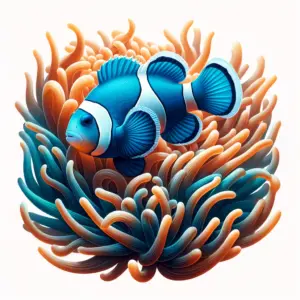
6.1. The Unique Beauty of Blue Clownfish
These clownfish are a visual treat with its striking blue coloration and playful demeanor. This unique coloration is not just a mere aesthetic feature; it plays a role in their interaction within the reef community. In an aquarium setting, these vibrant fish bring a dynamic element, drawing the eye and adding a splash of color. Their active swimming patterns and curious nature make them a joy to watch, offering an ever-changing and lively display.
6.2. Enhancing Your Aquarium with Blue Clownfish
Integrating these clownfish into your aquarium adds more than just beauty; it introduces a captivating aspect of reef life. Their presence can elevate the aesthetic appeal of your setup, creating a focal point that intrigues and delights. To fully showcase their beauty, consider pairing them with complementary tank decor and lighting that accentuates their vivid blue hues. Their interaction with other tank inhabitants and the environment adds an engaging and dynamic aspect to the aquarium experience.
7. Conservation and Ethical Considerations
7.1. Importance of Sustainable Practices
As enthusiasts, we bear a responsibility towards the conservation of these clownfish and their natural habitats. Promoting and practicing sustainable fishkeeping is not only ethical but also crucial for the preservation of marine biodiversity. This involves being mindful of our choices, from the selection of fish to the sourcing of aquarium supplies. Supporting conservation efforts and educating others about the importance of sustainable practices plays a vital role in the protection of these magnificent creatures and their ecosystems.
7.2. Ethical Sourcing of Blue Clownfish
When acquiring these clownfish, it’s important to consider the source. Ethically sourced clownfish are usually bred in captivity, which helps reduce the pressure on wild populations. Purchasing from reputable breeders or stores that prioritize sustainable practices ensures that you are contributing to the conservation of the species. Inquire about the origin of the fish and the practices used in their breeding and care. By choosing ethically sourced blue clownfish, we can enjoy our hobby without compromising the wellbeing of these creatures and their natural habitats.
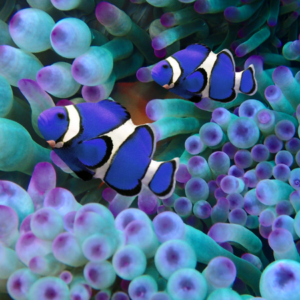
8. Conclusion
Caring for blue clownfish is a fulfilling venture that combines the joys of fishkeeping with the satisfaction of creating a slice of the ocean in your home. Their vibrant color, unique behavior, and the serene beauty they bring to an aquarium make them a cherished addition. By understanding their needs, providing proper care, and being mindful of conservation and ethical considerations, we can ensure these stunning creatures thrive both in our tanks and in the wild.
9. FAQs About Blue Clownfish
1.What is the lifespan of a blue clownfish in captivity?
Blue clownfish can live up to 10 years or more in a well-maintained aquarium, with proper care and a stable environment.
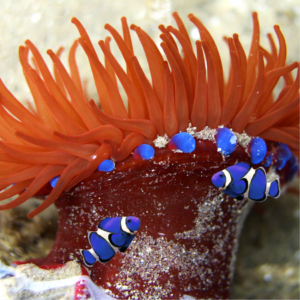
2.How can I differentiate between male and female blue clownfish?
Females are generally larger and more dominant than males. During breeding, these differences become more apparent.
3.Are blue clownfish easy to care for beginners?
Yes, blue clownfish are considered one of the hardier marine fish, making them a good choice for beginners in saltwater aquariums.
4.Can blue clownfish live without a sea anemone?
While they prefer living with anemones in the wild, these clownfish can adapt to life in an aquarium without one, provided their other environmental and social needs are met.
5.What are some common signs of stress or illness in blue clownfish?
Signs include loss of appetite, fading color, unusual swimming patterns, and spots or lesions on the body, indicating the need for immediate attention and possible changes in care or environment.
